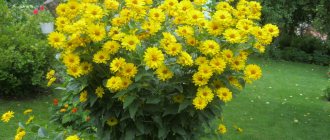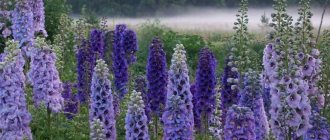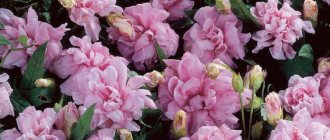10208
A winning option for landscaping a backyard area is growing boxwood; even a novice summer resident can handle planting and caring for this plant in the Moscow region. This is one of the most ancient ornamental representatives; today it is cultivated as a garden and indoor plant. A luxurious green fence, border or unusual topiary is grown from bushes on the site.
Boxwood hedges
Boxwood is a beautiful shrub in your yard
Despite the fact that this plant is heat-loving, it easily tolerates frost, and if you follow the correct planting and care technology, the shrub can delight you with its beauty for many years. Thanks to its luxurious crown, boxwood can be given any shape. The wood is quite dense, and the height of the bush can exceed 20 meters.
Today, more than 40 types of boxwood are known. The most popular tree in our area is the evergreen boxwood. The shrub grows slowly, but if it is not pruned, it can grow very large. The leaves of the plant are green and shiny. The flowers are small, the fruit is presented in the form of a round box with outgrowths. The plant is quite resistant to climatic surprises and rarely succumbs to attack by pests and various diseases.
Boxwood - planting and care
What is needed to plant a plant? First of all, high-quality planting material, which can be used as purchased seedlings or grown from cuttings. Boxwood can be planted at any warm time. This is mainly March – November. If seedlings are planted in the summer, then it is necessary to water them more often - this way they will better take root and prepare for winter.
Seedlings purchased in November cannot be planted; they need to be buried in the garden in the shade. You cannot bury seedlings in a hole, as this will destroy the plant. Boxwood is purchased with the soil in which it grew. The roots must be untangled. If this is not done, the plant may not take root in its new location.
Planting is carried out in several stages:
Stage 1. To plant the plant, you need a small hole, the depth of which should be slightly larger than the root system of the shrub.
Stage 2. Boxwood loves fertile soil, so it is recommended to fertilize it first. You can add fertile soil, humus, compost, humus, peat.
Stage 3. During planting, the plant is filled with a small amount of water, and the soil is compacted tightly. This is necessary so that when watering the water remains near the plant.
Stage 4. After completing planting, you need to water it abundantly. The first two weeks need to be watered daily, especially if the weather is hot.
After watering, the soil should be mulched using bark or peat. Three weeks is enough for the plant to take root. Then you can trim it.
What does caring for boxwood include? An important point is the application of fertilizer. As additional nutrition, you can use complex formulations containing nitrogen, potassium, and phosphorus. They are introduced in the spring. In the fall, fertilizers without nitrogen are applied. All fertilizers are applied dry, by spreading around the bush.
How to propagate boxwood? Reproduction is done by cuttings. For this purpose, material is prepared at the end of June, beginning of July. It is necessary to select young shoots. The cuttings should have internodes and several leaves. The finished cuttings are dipped into the peat mixture to the level of the leaves. Then cover the top with a jar or film. It is necessary to water the cuttings daily. After a week you can plant them in separate pots.
In autumn, the bush is placed in open ground. It will have time to take root before winter. For the winter, plants are covered with material so that they do not die due to frost.
So, boxwood, which is easy to plant and care for in the Moscow region , will be an excellent decoration for your summer cottage. Even if you are a novice gardener, you can easily cope with growing this beautiful shrub. We hope that our tips will be useful to you.
Boxwood (buxus, buxus, stone tree) has been known as an ornamental evergreen shrub for a very long time. This is one of the best plants for landscaping areas and creating hedges. It is flexible, easily tolerates shaping haircuts, and even in winter it can boast of its impeccable appearance.
When and how to plant
Good gardeners will do an excellent job of planting boxwood even in the hot summer, but we won’t split hairs and go to the garden in the fall. Before persistent frosts and snowfalls, the bush will have time to take root well and sleep until spring. Choose a shady place for your plant; direct rays of the sun can damage the leaves and cause unsightly spots to appear.
Read also: Sea buckthorn planting and care in open ground in the Urals
If you purchased a long-awaited seedling in a container, before replanting, water it thoroughly and leave it for a day. Why do this? The dry soil mixture will not stick together and will expose the roots, which will prolong the adaptation of the bush in open ground.
When planting boxwood, good drainage is necessary; for this, use coarse perlite. Add it to the soil; the root system of the shrub will quickly begin to develop in breathable soil. After planting the seedling, water it thoroughly and add soil.
General information about the plant
Boxwood belongs to the genus of evergreen plants . It has almost 100 different species. In the wild, axle grows in the Mediterranean, East Africa, Asia Minor, Central America, and the Caucasus.
Buxus is a shrub that in nature grows up to 15 meters , but in cultivation it is often no higher than 6 meters. The dense crown of the bush is covered with shiny, leathery, fragrant oval-shaped leaves. The upper part of the leaves is dark green, the bottom leaves are yellow-green.
In our climate, buxus rarely blooms. Small, fragrant yellow-green flowers appear in March - April.
Types of boxwood
The most common species in our country are:
- evergreen or ordinary;
- small-leaved;
- Colchian or Caucasian;
- Balearic.
Evergreen boxwood is found in the southern regions of the country both as an ornamental and as a wild plant (in the Caucasus). Growing is possible both in partial shade and in the sun .
Small-leaved native to Japan and Korea. Therefore, this species is more resistant to winter cold and, even without shelter, can withstand frosts down to minus 30 degrees. Colchis boxwood is listed in the Red Book. It is a long-liver and specimens are known to have lived to almost 600 years. It grows in height up to 20 meters with a trunk diameter of 30 cm.
Balearic boxwood is the largest species. Its leaves are up to 4 cm long and 3 cm wide. It is characterized by rapid growth and high decorative qualities. Wintering is possible only at positive temperatures.
Preparing boxwood for winter
When preparing a plant for winter, it is necessary to take into account the frost resistance of boxwood and, if necessary, think about whether it is worth building a shelter for it.
Winter hardiness of boxwood
This plant is quite capable of withstanding short-term cold snaps, but at stable low temperatures below -10°C it begins to freeze. Prolonged frosts can completely destroy the bush if no additional measures are taken. However, some boxwood varieties are more frost-hardy than others. So, hardy plant varieties include:
- "Blauer Heinz"
- "Handsworthiensis";
- "Herrenhausen";
- "Buxus Sempervirens".
Is it necessary to cover boxwood for the winter?
The decision about whether to cover the plant for the winter or not should be made based on the characteristics of the region in which the boxwood grows. In the southern regions, bushes up to 1 m high successfully winter under snow, but in colder regions, including the middle zone, care must be taken to protect the plant. This is necessary not only to prevent freezing, but also to hide the crop from the sun during thaws, since even a small amount of light can awaken boxwood from hibernation and start photosynthesis processes in the foliage. Due to frozen soil, nutrition will not be able to flow fully, and the plant will die very quickly.
How to cover boxwood for the winter
The construction of a winter shelter plays a key role in preparing the plant for the cold. To properly insulate boxwood for the winter, the following recommendations may be useful:
- The bushes should be covered after the temperature outside reaches a stable -10°C and the risk of possible warming has passed, otherwise the bush will dry out under the protective material.
- Standard plants and low-growing bushes are pre-tied, attached to the support with a rope so that they do not break off under the weight of snow.
- Low bushes do not need staking if wooden boxes with holes for ventilation are used for shelter.
- Instead of tying up plants up to 1 m in height, you can build wire frames over them. Such structures are covered with a protective layer, which is fixed to the ground using a weight.
- Tall varieties are covered with burlap, tightly wrapping the bush. In some cases, they use two U-shaped structures installed crosswise above the plant.
- The boxwood, which is part of the hedge, is carefully tied with a rope, dividing the plants into groups of several copies. Additionally, you can cover the tree trunk circles with spruce branches tied in bunches.
- If boxwood bushes grow side by side with roses, it is possible to make a common frame shelter.
- The fabric should be breathable and dark in color. Light-colored material is not suitable, as it attracts heat, which can cause the plant to dry out.
- For the same reason, plastic film should not be used for covering.
Planting evergreen boxwood
Choose a place for planting in advance: bright, but without direct sunlight.
Buxus grows in almost any type of soil, but the ideal soil for planting is:
- loamy;
- having neutral acidity;
- well drained.
Particular attention should be paid to drainage. This shrub simply will not grow in an area where water stagnates . In this case, it is better to grow it in large flowerpots.
The best time for planting young seedlings in the Moscow or Leningrad region is autumn. It will take about a month for the axle box to root. Therefore, the planting time must be calculated so that the seedling takes root before the first frost. Plants older than 3 years can be planted at any time of the year, except winter.
When purchasing seedlings, inspect them carefully: the foliage and shoots should be lush and green . Leaves with yellow spots indicate that the bush will soon die.
Planting is carried out after sunset or on a cloudy day. Dig a hole approximately three times the size of the seedling's earth ball. To plant a hedge, a trench is dug. A drainage layer is laid at the bottom. If the soil is poor, you can add fertile soil or compost on top of the drainage.
After removing the plant from the container, you need to carefully straighten all the roots . The quality and timing of its rooting depends on this. To make the soil looser and more breathable, you can add perlite to the soil. Place the seedling in the hole, fill it with soil, tamp it down lightly and water.
Features of caring for boxwood in the fall and preparing for winter
Although boxwood cannot be called a whimsical crop in the summer, the autumn months involve a fairly large amount of work associated with this plant. After all, it is quality care in the fall that will determine whether boxwood can quickly recover from winter with the arrival of warmth. When growing this plant on your site, it is worth remembering several important points:
- Boxwood leaves contain toxic compounds that can cause chemical burns. Therefore, caring for the plant must be done with rubber gloves, a robe and a face mask, which must be washed along with garden tools after each use.
- All care procedures, including pruning, watering and mulching, should be carried out before the arrival of frosty days.
- Since boxwood is very sensitive to the sun and begins to actively sprout at the slightest warming, it is worth planting it in the shade of large plants or near buildings on the north-eastern and north-western side.
- In spring, the cover from the bush is not immediately removed. First, the trunk circle is opened slightly at the very base of the plant, then after 7–10 days the protective layer is removed from the top of the boxwood. Snow and leaves are removed from the tree trunk circle so that the soil warms up faster.
Read also: DIY plaster hands master class
Rules for care and cultivation
During the growing season, care is quite simple. The first feeding is carried out a month after planting. Subsequently, fertilizing is repeated 1-2 times a month throughout the growing season. Fertilizers rich in nitrogen are applied in the spring, and phosphorus-potassium fertilizers are applied in the summer and autumn.
When watering, they are guided by weather conditions. If there is no rain, then water once every 1 - 2 weeks.
Before the onset of cold weather, the buxus is watered abundantly, and the soil around the trunk is mulched. Despite the fact that evergreen boxwood tolerates sub-zero temperatures quite well, prolonged severe frosts can destroy the plant . Small bushes are covered with boxes with ventilation holes. The hedge is covered with non-woven material specially designed for this purpose.
In the spring, do not delay cleaning the shelter to avoid possible damping of the axle box or the development of fungal diseases.
New growth must be pruned to maintain boxwood's shape . To get lush, beautiful bushes, trimming should be done once every 4 weeks.
Reproduction
Boxwood can be propagated:
- seeds;
- cuttings;
- layering.
Seeds
Buxus seeds are propagated extremely rarely . This is due to the fact that its seeds quickly lose their viability.
A growth stimulator (Zircon or Epin) is dissolved in warm water and fresh ripened seeds are soaked in this solution for 24 hours. After this, they are laid out between wet wipes or cotton pads. Within 2 - 3 weeks, white sprouts hatch.
Boxwood seeds
The seeds are placed in a container filled with a mixture of peat and sand in equal parts. In this case, the sprouts must be directed into the soil. Cover the top of the container with film or glass and place it in a warm place at home, shaded from direct sunlight.
After green sprouts appear, the glass or film is removed. They can be planted in open ground in the spring after the threat of frost has passed .
Cuttings
The most common method of propagating axle is spring cuttings. From an adult plant, young, non-lignified shoots about 15 cm long are cut at an angle.
The leaves are removed from the lower part of the cutting, the lower tip is dipped in Kornevin and buried in light, nutritious soil to a third of its length. Cover with a plastic bottle on top.
It is necessary to ventilate the plants daily . Water the cuttings by spraying water from a spray bottle on them. The first roots appear in about a month.
By layering
For propagation by layering in the spring, the shoot is bent to the ground and dug in . During the summer period, the buried shoot is watered and fed along with the mother bush. After the shoots begin to grow, they are separated and planted.
Boxwood propagation
The easiest and most economical way to propagate boxwood is by cuttings. Young shoots are cut from a healthy bush and planted in a light mixture of sand and fertile soil. You can use pieces of branches left over from the summer trimming of boxwood. To speed up rooting, you can use special preparations: Kornevin or its analogues.
The seedling is ready for planting in a permanent place when new shoots begin to develop.
Growing boxwood from seeds is much more difficult. Ripe seeds must be collected in late autumn. Before sowing, they are germinated for a long time on damp cloth. This period is often about a month. All this time you need to moisten the seeds with water. Sprouted seeds should be planted with the sprouts facing down in light sandy soil.
The method of propagation by seeds is a labor-intensive task, since the seed material has difficult germination. Yes, and it is very difficult to collect it with regular haircuts.
Diseases and pests
Most buxus diseases occur due to improper care or due to damage to the plant by pests.
The most common diseases are:
- root rotting;
- loss of foliage and shoots;
- late blight;
- white leaf spot;
- cytosporosis;
- drying of branches and leaves.
pests for this plant are the following :
- boxwood moth;
- gall midge;
- boxwood psyllid;
- spider mite;
- slowpoke;
- boxwood felt;
- scale insect;
- mealybugs.
Use in landscape design
Slow growth, plasticity, easy care, unpretentiousness, the presence of foliage in winter - all these qualities inherent in buxus open up endless possibilities for landscape designers to use this plant.
Separately planted bushes are given a variety of shapes using pruning: from simple geometric to complex shapes . Low-growing and slow-growing species are used to frame flower beds and lawns and create borders. Strong and tall-growing varieties produce a dense living fence that protects from noise, wind and prying eyes.
This shrub is also used to hide unsightly objects on the site: garbage cans, compost heaps. In flower beds, boxwood is often used as a background for other beautiful flowering plants.
A dense hedge or beautiful green figures will decorate any area; you just need to spend a little effort on the simple care of this wonderful plant.
A winning option for landscaping a backyard area is growing boxwood; even a novice summer resident can handle planting and caring for this plant in the Moscow region. This is one of the most ancient ornamental representatives; today it is cultivated as a garden and indoor plant. A luxurious green fence, border or unusual topiary is grown from bushes on the site.
Boxwood hedges
Wintering boxwood in the Moscow region
In the Moscow region, buxus does not tolerate winters the best, although it is considered relatively resistant to cold. It is destroyed by prolonged frosts when the air temperature drops below minus 20°C. The crown is dried out by icy winds. The bright spring sun burns the foliage. Under such conditions, the plant can die very quickly. This may be why many professional landscape designers rarely undertake to plant boxwood on the plots of their regular clients. Unless, of course, special conditions are created for this plant.
One of the serious problems in winter is the lack of moisture, which is difficult for roots to extract from frozen soil. This also leads to the death of the plant. It is imperative to carry out moisture-recharging (moisture-recharging) irrigation in late autumn. One landscape designer told me that good watering of the ground under the bushes with very warm (almost hot) water helps preserve boxwood bushes during winter thaws. This technique allows the roots to absorb moisture from the partially thawed soil. I didn't have to use this advice, but I took note of it.
A summer resident I know has been successfully growing boxwood bushes for more than five years. They overwinter there without shelter. Boxwood grows in an area protected from the wind in a semi-shaded place where a lot of snow accumulates in winter. Coniferous plants protect it from the rays of the low winter sun. Black pine needles are used to mulch the soil. During the freezing rain, the boxwood was practically undamaged.
My deplorable experience is associated with the death of several boxwoods that were left to winter on the site. I insulated and covered them, but long frosty periods led to the plants either drying out or remaining half-dead, requiring serious resuscitation. The catch is that boxwood tolerates relatively warm winters well, so we consider this crop to be winter-hardy even in the Moscow region. But a harsh winter comes, and the initially heat-loving plant dies. From time to time I renewed my attempts to grow boxwood in the Moscow region in the open air. The maximum success is growing one bushus on the site for four years, after which in the spring the bush about 90 cm high began to dry out. It suffered not so much from frost as from damping off at the end of winter - beginning of spring. That year, low-growing junipers died in many areas. My mature yew tree was also badly damaged.
Long-liver with character: description and advantages
Boxwood, or buxus (from Latin Buxus) is a slow-growing evergreen shrub or tree with a height of 0.7 to 15 m. It is widespread in East Africa, the Mediterranean, Asia Minor and Central America.
If boxwood is chosen for landscaping the local area, planting and caring for it in open ground will require the gardener to be attentive. But at the same time, a highly decorative bush will grow in the garden area, retaining its attractiveness for a long time. The lifespan of a buxus in nature reaches 500-600 years. For example, Nana fir cannot boast of such indicators. On the site, life expectancy is limited to several decades.
Boxwood plantings
Despite its apparent mediocrity, the shrub attracts gardeners with its glossy green leaves. The upper part of the leaf blades is dark, and the lower part is light, yellow-green. The leaves are elliptical in shape and remain on the branches all year round. In autumn, their color changes from green to dark brown.
Another reason to grow buxus is its pleasant aroma. It produces small yellowish-green flowers that bloom in April or May. Over time, fruit boxes measuring 1-1.5 cm in size form in their place.
Slow growth is a characteristic of the plant. The annual growth is 5-6 cm.
In wild conditions, the plant reaches 15 m; when grown on a plot, a maximum height of up to 6 m can be achieved. Boxwood, with proper care, is not capricious. Its main advantages:
- cold-resistant varieties can withstand temperatures down to -20 °C;
- tolerates heat without loss;
- withstands short-term waterlogging and drought;
- grows within the city, where the air is smoky and contains an increased amount of gases;
- responds painlessly to transplantation at any age;
Flowering begins at the end of April
- lends itself to any haircut, retains its shape well, so gardeners love to make geometric shapes and animals from it.
How to choose the best boxwood seedlings?
Plants are sold with an open or closed root system. If it is a closed type, then such a specimen can be planted in the summer. Specimens with an open root system require preparation before planting. The roots must be trimmed and placed in a bucket of warm water. Planting of such a sample is carried out only in the spring.
Signs of a quality seedling:
- the foliage is green and lush, without damage;
- yellow spots are a sign of a disease, so they should not exist;
- soil in a container without mold;
- the earthen lump is braided with roots.
When growing this representative, it is important to remember that it is poisonous. The composition contains the alkaloid buxin, which in toxic quantities causes vomiting, convulsions and respiratory arrest. In most cases, it is dangerous for domestic animals when branches after pruning are used as bedding.
Medicinal properties and contraindications
The chemical composition of all parts of the evergreen boxwood contains many tannins, alkaloids, bioflavonoids and resins. Preparations from the leaves and bark of the plant have been used since ancient times to treat coughs and indigestion.
Boxwood has a diuretic, diaphoretic, hypotensive and antiseptic effect. An infusion of the leaves has an analgesic effect; the decoction can be used to wash infected wounds and abrasions. In homeopathy, buxus is used to treat worm infections and rheumatism.
Official medicine practically does not use boxwood for the production of medicines, since it is a poisonous plant. In case of poisoning, convulsions, involuntary trembling of the limbs, skin hyperemia, breathing problems, vomiting and diarrhea are observed. If the victim is not provided with immediate medical assistance, death from respiratory arrest is possible.
Evergreen boxwood is the choice of those who love to enjoy greenery at any time of the year. It will be a bright spot in the garden even on the gloomiest gray days.
Varieties for the Moscow region
There are several dozen types of boxwood. The following species are used for cultivation in central Russia:
- evergreen;
- favorite small-leaved by many;
- Colchian, or Caucasian;
- Balearic.
Evergreen boxwood has dark green glossy foliage up to 3 cm in length. Most often it is a tree; shrubs are rare. Popular varieties:
Blauer Heinz
- Blauer Heinz is a variety that successfully tolerates prolonged frosts. It has leathery, bluish-green foliage and tough shoots. By 3-4 years it forms a dense crown with a diameter of 12-15 cm.
- Elegance, which grows up to 1 m in the shape of a ball, is recommended for creating green fences and indoor growing. The leaves are pinnate with a light border and do not lose their rich color in dry weather.
- Suffruticosa, or Suffruticosa (up to 1 m), is valued for its thick crown covered with small light green leaves. The more often it is cut, the more actively it begins to grow, thickening the shoots. Young growths should be trimmed. The flowers are small, but honey-bearing, and begin to appear at the end of April. This variety prefers semi-shaded places. It is better for him to spend the winter in the Moscow and Leningrad regions with shelter.
Varieties for the Moscow region
Small-leaved buxus is sensitive to cold, but there are also frost-resistant varieties:
- Winter Gem is a dense bush up to 1.5 m in height, which can be shaped. Used to create shaped objects.
- Faulkner is a miniature type of buxus, from which a ball is most often formed.
The Colchian, or Caucasian species is most suitable for survival in the middle zone. It tolerates cold and sunlight better than others, and has the smallest foliage. It can live up to 600 years, growing up to 20 m. It goes well with almost any flowering shrubs.
Balearic is the largest and fastest-growing species, but wintering is possible only at positive temperatures.
Some varieties survive winter not only in the Moscow region, but also in Siberia due to their resistance to cold. In such regions, more attentive care, regular feeding and careful preparation for winter are required. Colchian and Balearic species practically do not take root in cold regions, but varieties of evergreen boxwood do well.
Description of the bush
Boxwood or buxus is a perennial evergreen shrub with leathery, ovate leaves and small fragrant flowers. The seeds are formed in a box, which, when fully ripe, opens and throws them in different directions.
Boxwood is a good honey plant, but honey collected from boxwood cannot be consumed, as the plant is poisonous. Beekeepers need to remember this when placing an apiary on their summer cottage.
In landscape design, buxus is indispensable, since its dense crown with shiny leaves tolerates pruning and crown shaping.
Important! Boxwood is a long-liver; life expectancy with good care can be up to five centuries.
Nowadays, more than 40 types of buxus are known, but the variety that is ideal for growing in the Moscow region is evergreen boxwood (Buxus sempervirens). This variety naturally grows up to 15 meters and has tetrahedral, densely leafy green shoots. The petiolate leaves are dark green in color and grow up to 3 cm in length. The best varieties of evergreen boxwood:
- Suffruticosa is a slow-growing evergreen shrub. The leaf blade is ovoid, the flowers are small and fragrant. The plant looks good in hedges and borders.
- Blauer Heinz is a compact and frost-resistant shrub. Used to create carpet patterns no higher than 20 cm. The leaf blade is leathery, bluish-green in color.
- Elegance is a leafy shrub with a spherical crown.
Choosing a place and timing of landing
To grow a decorative specimen, you need to choose the right place for placement. First of all, the level of illumination is taken into account. Boxwood grows successfully in a shaded area, but in conditions of constant light the foliage may suffer. Full sun is acceptable if the soil is light and fertile and watering is regular. Bushes do not tolerate drafts well, so choose a place protected from the wind, for example, along a wall or under a large tree. For the development of roots, a retreat of at least 1 m is required from the bush to the building.
Planting work
Boxwoods are grown in loose soils with drainage. Humidity is welcome, but waterlogging has a negative effect on the roots. The plant does not like acidic soils, so choose areas containing lime. In the Urals and Siberia, when planting in poor soil, add compost or fertile soil to the hole. To loosen the soil, additional perlite is added.
Boxwood should be planted in the spring so that the plant has time to take root and settle into the area before the onset of cold weather. Some gardeners allow planting in the fall. The main thing is to do this before frost, so that the seedling has time to adapt.
To plant a bush correctly, you should follow a few simple rules:
- Planting work is carried out in cloudy weather or in the evening.
- A hole is dug three times larger than the earthen clod. If a hedge is planted, then prepare a trench instead of several holes.
- A drainage layer is laid at the bottom of the hole or trench.
- The seedling in the container must be watered abundantly the day before planting.
- All roots are carefully straightened. The seedling is placed in a hole and covered with earth. The soil can be lightly compacted.
- Immediately after planting, the tree trunk circle is watered and mulched with peat, leaf humus or compost.
Video with landing details.
Landing axle box
Since the plant is perennial and can grow for more than one century, the choice of location must be approached with all responsibility.
Evergreen shrubs can be planted from spring to late autumn. Before planting, you need to select a place and prepare the soil.
Heavy, acidic soil with nearby groundwater will not suit boxwood, therefore, the soil structure needs to be improved before planting.
Although boxwood came to us from southern countries, it does not tolerate direct sunlight. In open areas, the plant's leaves are damaged and it loses its decorative effect.
How to plant boxwood correctly:
- 24 hours before planting, the seedlings are placed in warm water with the addition of Kornevin.
- The hole is dug three times wider and deeper.
- Drainage 3 cm thick is laid at the bottom.
- A seedling with a straightened root system is placed in a hole and carefully sprinkled with earth, making sure that no voids are formed.
- After filling the hole, the soil is compacted and watered thoroughly.
- After watering, the soil is hilled up and mulched.
- The distance between bushes should be at least 30 cm.
Important! After planting, the shrub is watered every day for two weeks.
Shrub care: watering, fertilizing, pruning
The rules for caring for boxwood include watering, fertilizing, pruning and preparing for winter. It is enough to water the bush once a week during the entire growing season in the absence of rain for a long time. The first application of fertilizers is made a month after planting, then the bush is fed monthly. In the spring, buxus will need nitrogen fertilizers, in the summer and autumn - potassium and phosphorus.
Fertilizers for ornamental shrubs:
- specialized drug "Buxus-Azet";
- mineral complex PETER PEAT;
- For organic fertilizers, mullein solution (1:10) and bird droppings (1:20) are suitable.
The main reason for choosing a boxwood bush is its predisposition to form topiary figures. From the evergreen buccus you can grow a ball, cube, pyramid and more complex shapes. To maintain the shape, only new growth is pruned. Trimming stimulates the branching of the bush. The frequency of the procedure is once every 4 weeks. In the Moscow region, pruning can begin in April.
Haircut of young growth
Boxwood shelter for the winter
One of the difficult stages in care is the transition of boxwood into a dormant state and its wintering. The boxwood tree is prepared in advance for the onset of cold weather. In the fall, before frost, it is watered abundantly. The tree trunk circle is mulched to prevent the root system from freezing. It is better to cover the soil with peat rather than foliage, since during the winter it can rot and block the access of air to the roots.
Covering methods:
- Small specimens can be covered with boxes with ventilation holes. Large bushes and hedges are insulated with non-woven material or spruce branches.
- Border plantings are covered with non-woven insulation, burlap or special nets to prevent branches from breaking off under the snow.
- Standard boxwoods are tied to supports and wrapped in spruce branches.
Boxwood in winter in the Moscow region needs to be protected from sunlight. Most often, the plant suffers from bright rays, and not from cold. The bush is at rest, and if there is an excess of light in the leaves, the process of photosynthesis can begin. When the soil is frozen, the plant goes hungry, which can cause it to turn brown, dry out, or even die. In the spring, with the arrival of warmth, the shelter is removed as soon as possible so that fungal diseases do not begin to develop.
Boxwood caterpillar
Removing protection
We’ve figured out how to cover boxwood for the winter, but what to do next?
With the onset of warm spring days, most gardeners rush to immediately free the plants from their shelters. There is no need to rush to do this. If you open the boxwood before the snow has completely melted and the ground has warmed up even a little, this can harm the bush.
Read also: Mannik with poppy seeds and sour cream
Leaves and stems under the spring sun will begin to actively evaporate moisture, and the roots at this time cannot yet work properly. As a result, the aboveground part will dry out and the plant may die.
You need to gradually accustom the shrub to the sun. It is necessary to open it for the first time on a cloudy day. So that the bright sun does not burn the foliage. In the first week, if the sun is shining brightly, covering material is thrown over the bushes during the day.
Only when the boxwood gradually gets used to it and the main snow cover has melted can you untie the ropes securing the branches.
By observing all these conditions and knowing exactly whether boxwood needs to be covered for the winter, you will help the bushes survive harsh winter conditions, and your plants will delight you with their beauty for more than one season.
If you find an error, please select a piece of text and press Ctrl+Enter.
In landscape design, an evergreen ornamental shrub from the Boxwood family, called buxus or evergreen boxwood, is often used. In its natural environment, this plant is found almost everywhere in many Mediterranean countries, as well as in Southeast Asia. The tree is not tall, grows slowly, tolerates pruning well. Boxwood is considered one of the most convenient plants for forming living fences, borders and garden figures.
Read on Dacha6.ru:
Boxwood tolerates frosty winters, which are typical for central Russia. The main thing is that the winter should be snowy. Under the covers of snow there are boxwood bushes, as a rule. winter without any significant losses.
In a garden plot, it is better to plant boxwood in shady places (under larger coniferous plants, not far from country houses, on the northwest and northeast sides of them). The fact is that during prolonged winter thaws, boxwoods located in open areas and warmed by the sun can begin to grow. As a result of such untimely awakening, the leaves and shoots dry out, and gradually this destructive process can become inevitable. In shady places, even during a thaw, the snow cover will melt very slowly, and the plant will continue to be dormant.
For the winter, it is recommended to additionally cover evergreen boxwoods. To begin with, the soil under them is mulched with a layer of rotted pine needles or peat. Some summer residents use dry leaves for this, but in this case it should be borne in mind that during prolonged thaws it may begin to rot.
In late autumn, boxwood should be covered with light burlap and gauze (in snowless winters these materials can be covered in several layers), as they allow air to pass through well and at the same time reliably protect these plants from winter sunburn. Do not use non-woven materials to cover boxwood, as during a thaw the plants underneath may rot. If possible, build simple wooden structures around the bushes, onto which you then attach covering material. Such a frame will not only protect from the winter sun, but will also take on the main load of containing thick layers of heavy wet snow.
The autumn-winter period is an extremely important time for any plant grower, since many plants require increased attention just before the onset of cold weather. This is true for a wide variety of crops, including frost-sensitive boxwood. Therefore, it will be useful for everyone who has the pleasure of growing this wonderful plant on their plot to know what it means to care for boxwood in the fall and how to properly prepare it for winter.











